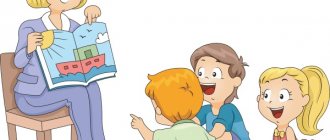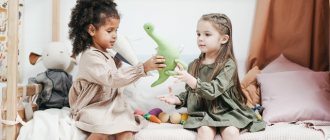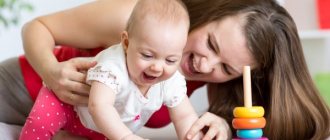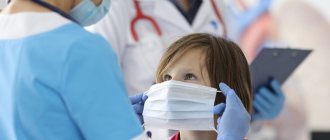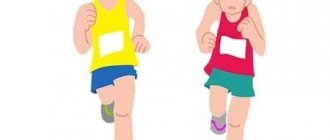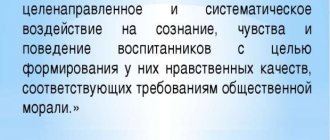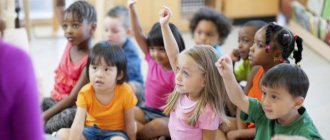Violation of these rules leads to a decrease or absence of the positive effect of hardening, and sometimes to hyperactivation of the neuroendocrine system and its subsequent depletion.
Hardening activities are divided into general and special.
General ones include a proper daily routine, balanced nutrition, and physical exercise.
Special hardening procedures include:
- air hardening (air baths),
sun hardening (sunbathing),
Air baths.
The first hardening procedure for an infant is air baths. It must be remembered that the air temperature in the room for a newborn baby should be 23°C, at the age of 1 to 3 months. — 21°С, from 3 months. up to 1 year - 20°C; over 1 year - 18°C. Infants have high energy costs and oxygen consumption (2.5 times more than adults), so it is necessary to ventilate the premises 4-5 times a day for 10-15 minutes. in winter, keep the windows open almost constantly in summer. Ventilation using a window or transom is carried out in the presence of children; the air temperature drops by 1 - 2°C, which is a hardening factor. It is advisable to carry out cross-ventilation when there is no child in the room. It is possible to use air conditioners and microclimate systems that automatically regulate temperature and humidity.
In the summer, newborns can be taken for a walk almost immediately after birth, initially for 20-40 minutes, quickly increasing the time to 6-8 hours a day.
In winter, children are first taken outside at the age of 2 - 3 weeks at an air temperature of at least -5 ° C for 15 - 20 minutes. and gradually increase exposure to air to 1.5 - 2 hours 2 times a day.
Air baths themselves begin to be carried out in the maternity hospital, when, when changing diapers, the child is left for a short time without clothes. Air baths should be carried out in a well-ventilated room at an air temperature of 20 - 22 ° C (for infants) and 18 - 19 ° C (for children 1 - 2 years old). Initially, the duration of the procedure is 1 - 2 minutes, every 5 days it increases by 2 minutes. and reaches up to 15 minutes (for children up to 6 months) and up to 30 minutes (after 6 months). Air baths must be combined with gymnastic exercises.
Hardening children at home
In winter, children get sick especially often. Simple hardening procedures can help support their body.
Factors predisposing to frequent diseases are: an abundance of contacts with children and adults with acute respiratory diseases, immaturity of the body’s defense systems in preschool age, adverse effects of environmental factors, improper organization of the daily routine, excessive “wrapping up” of children by parents according to the principle “the Siberian is the one who is warmer.” gets dressed”, lack of vitamins and microelements in the diet, lack of regular hardening activities.
All this poses a threat to the normal physical development of the child and poses a serious problem for parents, both psychologically and financially. Often, a child treated for a respiratory infection becomes ill again after a short period of time, without having time to recover from the previous illness. In this regard, mothers and fathers, fearing that their children will catch a cold, do not walk with them in cool weather, dress them too warmly, do not ventilate their apartments, and do not wash them with cold water. But all their efforts do not bring success. As a result of “greenhouse” upbringing, the child’s body becomes pampered and weak. Often, mothers, disillusioned with traditional medicine, turn in desperation to various types of healers and healers, with the vain hope of a quick healing.
A real healing effect can be achieved with the help of regular hardening measures, especially in combination with parallel drug immunocorrection aimed at increasing the body's defenses, which can result in a reduction and alleviation of respiratory diseases, and in an ideal situation, the occurrence of ARVI no more than 1-2 times in year.
The meaning of hardening is repeated repeated loads of the same type, most often cold ones, as a result of which fitness is developed in relation to these loads, the protective reactions of the immune system are activated, and therefore resistance to colds increases, first of all, and also affects all other functions of the body - Appetite and food absorption improve, growth normalizes, mental and physical performance increases, and a joyful mood appears.
Parents should remember that the training effect of hardening procedures does not last long, especially in preschool children, this is approximately 3-10 days, while to achieve this effect a period of at least a month is required, and in weakened children, even more. You should not force the complication of hardening procedures, as this can lead to disruption of adaptation mechanisms and the appearance and resumption of recurrent diseases.
Basic rules of hardening:
1. Hardening procedures should be carried out only if the child is healthy. You can start at any season of the year, but it’s better in the summer.
2. Continuity. If the cold factor affects the body systematically, repeatedly, a rapid reaction of blood vessels to the influence of low air and water temperatures occurs. On the contrary, the randomness of hardening procedures and long breaks reduce the body's resistance and can lead to the opposite effect.
3. Gradualism. It is unacceptable to decide to harden a child, immediately pour cool water on him, and send him out for walks in inclement weather, lightly dressed. This will certainly lead to the fact that the baby will catch a cold, and the mother will henceforth be afraid of hardening, like “fire”. You need to start carefully, moving to stronger hardening procedures gradually.
4. It is necessary to take into account the individual characteristics of the child. For example, excitable, “nervous” children sometimes react poorly to cold water.
5. Constantly monitor the child’s reaction to hardening procedures. If, during a douche or an air bath, the baby trembles, his skin becomes “goosey,” it means that he is not yet adapted to this temperature. Next time the procedure should be carried out starting with the dosage that did not cause any negative effects.
6. We must strive to ensure that children enjoy hardening and perceive it as fun.
7. If the temperature rises, runny nose, cough, loose stools, it is necessary to stop hardening or carry out it at a gentle level. Hypotrophy, anemia, rickets are not contraindications to hardening.
8. When starting hardening, create healthy living conditions for your child, a normal psychological atmosphere in the family, and adequate sleep. It is necessary to throughly ventilate the room at least 4-5 times a day, each time for at least 10-15 minutes.
9. Children 1.5 years and older need to walk at least twice a day for 2.5-3 hours. In winter, when temperatures are lower, walking time is limited. Children from the age of 2.5-3 years can be taught to ski, skate, scooter, and bicycle. In the summer, there is no need to prohibit playing in the water, walking barefoot on the ground, on the grass, on the sand by the river. Clothes are of great importance: it is important that they fit, so that the child does not get cold or overheat in them. All these measures also have a certain hardening effect.
Special hardening activities are: ultraviolet irradiation, gymnastics, massage, air, light-air, water procedures, including swimming, reflexology, sauna.
At different age periods, hardening is carried out in different ways, according to the principle from simple to complex.
Hardening methods:
1. Air baths: in the room in winter, outside in summer at a temperature of +22+28 C, preferably in the morning. You can start from the age of two months, at first 1 minute 2-3 times a day, after 5 days increase the time by 1 minute, bringing it to 15 minutes by 6 months and to +16 C by a year.
2. Hardening with sunlight: better in the shade of trees, in calm weather, at an air temperature of at least +22 C. Starting from the age of 1.5-2 years, children can sunbathe in just panties, duration from 3 to 10 minutes, increasing by 7 -10 days to 20-25 minutes. The optimal time is from 9 to 12 noon.
It is unacceptable for children to stay “in the sun” at an air temperature of +30 C or higher, due to possible overheating.
3. Wet rubbing: carried out with a piece of clean flannel soaked in water and wrung out, once a day for 1-2 minutes. Start with the arms - from the fingers to the shoulder, then the legs, chest, stomach and back until slightly reddened. Water temperature at the age of 3-4 years +32 C, 5-6 years +30 C, 6-7 years +28 C; after 3-4 days it is reduced by 1 C and brought to +22 +18 C in summer and +25 +22 C in winter. Upon completion, the child should be warmly dressed. In case of a break, start with dry rubbing.
4. Hardening of the oropharynx: rinsing the oropharynx with any disinfectant herb 3-4 times a day (better after visiting a kindergarten, school, cinema, etc.). After preparation, divide the infusion in half, rinse alternately, once a week reduce the temperature in the second glass by 0.5-1 C. Start with a temperature of +24 +25 C.
5. Foot baths: dousing the feet for 20-30 seconds with water at a temperature of +32 +34 C, with a gradual decrease once a week by 1 C to +10 C. You can alternate cold and warm dousing, 3-6 times. At the end, the legs are rubbed until the skin turns pink.
6. General dousing: start from 9-10 months, do not douse the head, while the child is standing or sitting. Water temperature under one year of age is +36 C, 1-3 years +34 C, over 3 years +33 C. Gradually decreasing by 1 C per week, to +28 C in winter and +22 C in summer. Duration up to 1.5 minutes. Then rub the body with a towel until it turns pink.
7. Shower: after 1.5 years. It’s better in the morning for 30-90 seconds at a water temperature of +34 C, gradually reducing to +28 C in winter, and +22 C in summer.
8. Bath (sauna): start with one session for 5-7 minutes on the bottom step (shelf), it is advisable to put a woolen cap on the child’s head. In the future, the number of visits increases to three times. After each entry, you need to cool down for 10 minutes, preferably in the shower. In the bathhouse and after visiting it, you need to take a small amount of berry juice or herbal tea. You can visit the bathhouse from 2-3 years of age. Visiting the bathhouse is contraindicated for children with severe chronic and congenital diseases.
9. Swimming: one of the most effective forms of hardening. Combines the influence of water, air, temperature, and physical activity of the child. You can start training from the first months of life, but under the mandatory guidance of an experienced instructor.
10. Effective hardening measures are physical therapy and massage, which should be carried out by qualified specialists.
Hardening can be carried out for most children, but you should first contact your pediatrician at your place of residence; it is advisable to follow a certain sequence in increasing hardening loads. It is especially important to carry out hardening when preparing children to attend kindergarten or school.
Sun hardening.
Ultraviolet rays actively affect the immunological resistance of the body. However, the younger the child is, the higher the sensitivity to ultraviolet rays. Therefore, sunbathing is contraindicated for children under one year of age. They are prescribed with caution to children from 1 to 3 years of age, and only at an older age they are carried out quite widely. Scattered sunlight contains a lot of ultraviolet and relatively few infrared rays, which cause overheating of the child’s body, which is especially dangerous for children with increased neuro-reflex excitability.
In autumn, winter and spring, direct sunlight does not cause overheating, so getting it on the child’s exposed face is not only acceptable, but also necessary. In summer, it is recommended to carry out light-air baths at an air temperature of 22 ° C and above for infants and at 20 ° C for children 1 - 3 years old, preferably in calm weather. In central Russia, light-air baths are best carried out from 9 to 12 noon, in hotter climates from 8 to 10 am. The duration of the first bath for infants is 3 minutes, for older children - 5 minutes. with a daily increase to 30 - 40 minutes or more. An absolute contraindication to sunbathing is an air temperature of 30°C or higher. After sunbathing, children are prescribed water treatments. Since the body becomes hypothermic when the skin is wet, it is imperative to dry the child, even if the air temperature is high.
Middle group. Junior preschool age. Children 4 - 5 years old
Summary of hardening procedures after daytime sleep in the middle group. Summary of hardening procedures after daytime sleep in the middle group. Educator: Pugina K.V. 2022. Purpose: Prevention of colds using hardening procedures . Tasks. Educational: Preserve and strengthen the physical and mental health of the child….
Organization of physical education, health and hardening activities in the middle group The most precious gift that a person has received from nature is health. No matter how perfect medicine is, it cannot save each of us from diseases. “Every person’s health comes from physical education, hardening , and a healthy lifestyle!” - these words belong to the great...
Water procedures.
The thermal conductivity of water is 30 times, and the heat capacity is 4 times greater than air, so water hardening has a more powerful effect on the body compared to air procedures. The method of water hardening depends on the age of the child. It is necessary to introduce an element of hardening into ordinary water procedures (washing, rinsing, bathing).
Water procedures are divided into traditional and non-traditional, or intensive.
Traditional water treatments
Child's age from birth to 2 - 3 months.
1. General baths - the child is bathed daily with water at a temperature of 37 - 36 ° C for 5 minutes, then doused with water at a temperature 2 ° C lower.
2. Washing, washing, which lasts 1 - 2 minutes, is first carried out at a water temperature of 28 ° C, every 1 - 2 days and reduced by 1 - 2 ° C and brought to 20 - 22 ° C.
3. Local wet wiping - with a mitten moistened with water at a temperature of 33 - 36 ° C, wipe the arms from the hand to the shoulder, then the legs from the foot to the knee for 1 - 2 minutes. Once every five days, the temperature is lowered by 1° C and brought to 28° C. Each part of the body is wiped dry until slightly reddened immediately after wiping it wet.
The child's age is from 2 - 3 to 9 - 10 months.
1 and 2 as in the previous age group.
3. General wet wiping. First, the upper limbs are wiped, then the lower ones, and finally the chest and back. The water temperature is the same as for local rubdowns. You can add salt to the water (2 teaspoons of salt per 1 glass of water). The same rule must be followed - wipe each part of the body dry immediately after wiping it.
The child's age is from 9 to 10 months. up to 1 year
1 and 2 as in previous age groups.
3. General dousing. During this procedure, the child can sit or stand. The flexible shower hose should be kept close to the child’s body (25 - 30 cm). The water jet must be strong. First they pour on the back, then the chest, stomach, and lastly the arms. After dousing, wipe dry until slightly red. Initially, the water temperature is 35 - 37 ° C, then every 5 days it is reduced by 1 ° C and brought to 28 ° C.
Why do you need to harden your kids?
It is difficult to overestimate the importance of hardening for a growing organism. Preschool children who are not afraid of the cold get sick less, which means they develop better and communicate more with their peers. A seasoned child is unlikely to get sick while airing the room, from eating ice cream, or if he sweats during a walk.
Home hardening involves not only regular procedures, but sometimes also a change in lifestyle. Unfortunately, not all adults are ready to adapt to the new regime, but it is by our own example that we show the child what is good and what is bad.
And yet, hardening does not completely eliminate the possibility of ARVI. No matter how strong the immune system is, no person can be 100% immune from the effects of viruses. However, a hardened body will more easily tolerate an infection and cope with it faster.
Contrasting and non-traditional hardening.
Intensive (non-traditional) hardening methods include any methods in which there is at least short-term contact of a naked human body with snow, ice water, or subzero air.
There is sufficient experience in intensive hardening of young children in parental health clubs. However, there are practically no scientific studies indicating the possibility of using this type of hardening. Therefore, most authors dealing with the issues of hardening young children consider bathing children in ice water to be contraindicated.
There is contrast hardening as a transitional step between traditional and intensive hardening: contrast foot baths, contrast rubdown, contrast shower, sauna, Russian bath, etc. Contrast hardening is more effective than hardening only with cold. The most common method for children is contrast dousing of the feet (you cannot pour cold water on cold feet, the feet must first be warmed).
There are also so-called pharmacological methods of hardening - the use of immunostimulants that enhance interferon formation. Some authors recommend their use for the prevention of frequent respiratory diseases in young children. However, this issue has not been sufficiently studied, and the results of the therapeutic experience indicate that there is no effect of treatment with immunostimulants on the level and dynamics of respiratory morbidity.
Secrets of children's health
Parents should remember that hardening does not provide a 100% guarantee of the absence of diseases. This is just one of the important components of a healthy lifestyle. It is also necessary to take care of proper nutrition and create a healthy microclimate, and also not to forget that the body needs immune support “from the inside.” For this purpose, experts recommend the use of special drugs - immunomodulators, capable of maintaining the immune system in full combat readiness, which is also important during hardening, when the body is subjected to serious tests. One of the most effective and safe preventive agents recommended in domestic pediatric practice is Anaferon for children. When taking this drug, reliable protection is provided against viruses, to which a weakened body is especially susceptible.
Doctor Komarovsky's opinion
The famous doctor Komarovsky, who gives advice on children's health issues on television, believes that a newborn child does not need special hardening manipulations. It has natural defense mechanisms that just need to be supported with appropriate care. Komarovsky recommends:
- do not bundle up babies;
- create temperature contrasts;
- do not be afraid of drafts;
- walk more in any weather;
- maintain a suitable temperature in the room;
- humidify the air and ventilate the room more often.
If these conditions are met, the baby will be able to grow up healthy without being doused with cold water and walking barefoot in the snow. If, from an early age, the baby was in a stuffy room, walked with him little and was protected in every possible way, he will be much more susceptible to viruses. He recommends that parents of such children start not with hardening, but with creating optimal conditions for the child, under which the body’s protective functions will work again.
He suggests paying attention to the following aspects:
- Cloth. If a child is hot, he will get sick faster. Do not bundle up your baby and remember that he needs to be dressed a little lighter than an adult. Suitable clothing should not restrict movement.
- Nutrition. Don't force feed your baby. With regular walks and optimal room temperature, the baby's appetite will improve on its own.
- Active pastime. To prevent a child from freezing during a walk, he must actively move and play. Come up with an activity that you both enjoy and enjoy spending time outside.
Dr. Komarovsky also calls for taking into account the individual characteristics of the child and not imposing hardening procedures on him.

Hardening requires parents to be persistent, self-confident and attentive to the baby. Any procedures should be carried out wisely, after consulting with a pediatrician in advance, especially if the child is weakened or has chronic diseases. The main thing in hardening is gradualism, so don’t rush things. Over time, you and your baby will adapt to new conditions, and you will not be so afraid of viruses and bad weather.
The final decision about whether to harden a child and what procedures to choose is made only by the parents. It is important that they use common sense and pay attention to their baby’s reaction to any manipulation.
